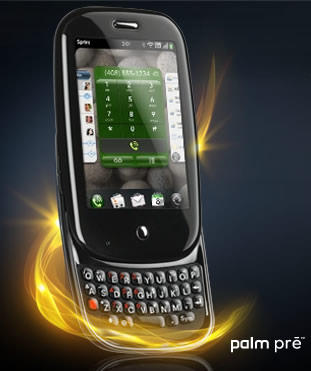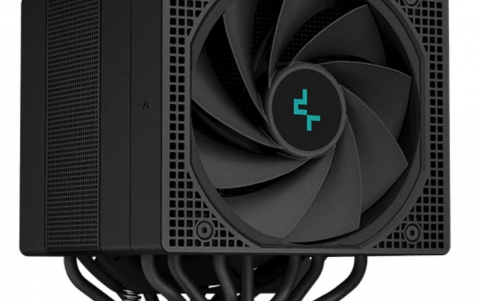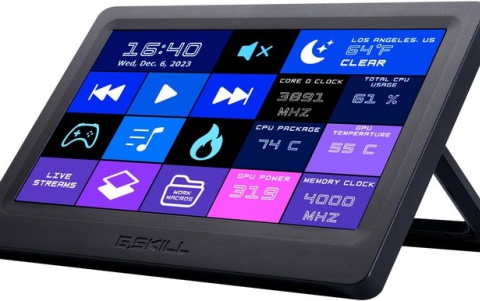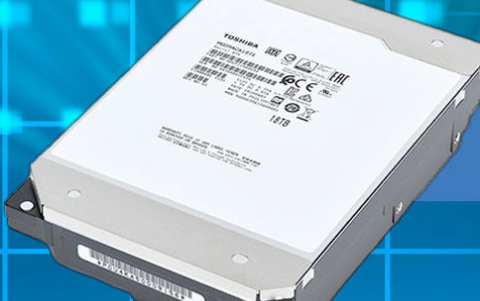
Palm Debuts "Pre" Smartphone, webOS Operating System at CES
Palm took the wraps off its o
Palm debuted the Palm Web OS, the new operating system developed under the watch of former Apple executive Jon Rubenstein, who helped create the iPod. It also unveiled the Pre smartphone, a touch-screen device with GPS, Wi-Fi and a slide out full keyboard. It will be available exclusively on the network Sprint Nextel in the first half of 2009.
Palm had been steadily losing market share to the iPhone, Research in Motion's BlackBerry and other devices.
 The new platform introduces Palm Synergy, a key feature of webOS.
With Synergy, you have a single view that links your contacts from a variety of sources. For example, if you have the same contact listed in your Outlook, Google and Facebook accounts, Synergy recognizes that they?re the same person and links the information, presenting it to you as one listing. And if you update a contact on your webOS device, it also will be updated in your various accounts, whether on a personal computer or on the web.
The new platform introduces Palm Synergy, a key feature of webOS.
With Synergy, you have a single view that links your contacts from a variety of sources. For example, if you have the same contact listed in your Outlook, Google and Facebook accounts, Synergy recognizes that they?re the same person and links the information, presenting it to you as one listing. And if you update a contact on your webOS device, it also will be updated in your various accounts, whether on a personal computer or on the web.
Your calendars can be seen on their own or layered together in a single view, combining work, family, friends, sports teams, or other interests. You can toggle to look at one calendar at a time, or see them all at a glance.
Synergy also lets you see all your conversations with the same person in a chat-style view, even if it started in IM and you want to reply with text messaging. You can also see who?s active in a buddy list right from contacts, and start a new conversation with just one touch.
Applications are seamlessly connected to the web and always active.
Palm?s webOS also lets you manage multiple activities more effectively by letting you keep multiple applications open and instantly flip from one to another.
With its multi-touch interface, webOS lets you move easily between activities like flipping through a deck of cards and rearrange items simply by dragging them; when you are done with something, just throw it away. And finding what you need is easy with universal search ? as you type what you?re looking for, the OS narrows your search and offers results from both your device and the web.
When important things come up or new updates arrive, you?ll receive notifications with a diplomacy that?s a radical departure from other mobile platforms. For example, if you receive a text message or email, a scrolling notifications bar at the bottom of your screen lets you address it right away or leave until later.
In a demonstration at CES, Palm executives showed how the Pre phone easily consolidates multiple communication services such as instant messaging, text messaging and social networks such as Facebook, and multiple email systems. w, Pre looks similar to the iPhone, with a face dominated mostly by a 3.1-inch touch screen and single button. The body of the Pre is black and slightly curved, with a full QWERTY keyboard that slides out from the bottom. The Pre will come loaded with features including Wi-Fi, stereo Bluetooth and GPS, as well as 8 gigabytes of storage space, a 3-megapixel camera and music and video playback. The Pre also has a variety of sensors, such as an accelerometer so images on the screen will rotate when a user turns the device on its side.
Pre will support a variety of differentiated on-device Sprint services, including Sprint TV, offering a selection of live and on-demand programming. Sprint Navigation provides GPS-enabled audio and visual turn-by-turn driving directions, one-click traffic rerouting and more than 10 million local listings.
Palm Pre features include the following:
- High-speed connectivity (EVDO Rev. A or UMTS HSDPA)
- Wi-Fi 802.11 b/g
- Integrated GPS
- 3.1-inch touch screen with a vibrant 24-bit color 320x480 resolution HVGA display
- Gesture area, which enables simple gestures for navigation
- Slide-out QWERTY keyboard
- Email, including Outlook EAS (for access to corporate Microsoft Exchange servers), as well as personal email support (POP3, IMAP)
- Messaging support (IM, SMS and MMS capabilities)
- Web browser
- Multimedia experience and performance (pictures, video playback, music), featuring a 3-megapixel camera with LED flash and extended depth of field, and a standard 3.5mm headset jack
- Bluetooth 2.1 + EDR with A2DP stereo Bluetooth support
- 8GB of internal user storage (~7.4GB user available)
- USB mass storage mode
- MicroUSB connector with USB 2.0 Hi-Speed
- Proximity sensor, which automatically disables the touch screen and turns off the display whenever you put the phone up to your ear
- Light sensor, which dims the display if the ambient light is dark, such as at night or in a movie theater, to reduce power usage
- Accelerometer, which automatically orients web pages and photos to your perspective
- Dimensions: 59.57mm (W) x 100.53mm (L, closed) x 16.95mm (D) [2.35 inches (W) x 3.96 inches (L, closed) x 0.67 inches (D)] - Weight: ~135 grams [4.76 ounces]
Palm Pre is scheduled to be available first in the United States exclusively from Sprint in the first half of 2009, and will be followed by a world-ready UMTS version for other regions. Sprint?s pricing for the phone has not yet been determined.
At CES, Palm also showed the Touchstone, a small round cosmetics jar-sized inductive charging dock that powers the Pre phone simply by placing the handheld on the dock.
Palm had been steadily losing market share to the iPhone, Research in Motion's BlackBerry and other devices.
 The new platform introduces Palm Synergy, a key feature of webOS.
With Synergy, you have a single view that links your contacts from a variety of sources. For example, if you have the same contact listed in your Outlook, Google and Facebook accounts, Synergy recognizes that they?re the same person and links the information, presenting it to you as one listing. And if you update a contact on your webOS device, it also will be updated in your various accounts, whether on a personal computer or on the web.
The new platform introduces Palm Synergy, a key feature of webOS.
With Synergy, you have a single view that links your contacts from a variety of sources. For example, if you have the same contact listed in your Outlook, Google and Facebook accounts, Synergy recognizes that they?re the same person and links the information, presenting it to you as one listing. And if you update a contact on your webOS device, it also will be updated in your various accounts, whether on a personal computer or on the web.
Your calendars can be seen on their own or layered together in a single view, combining work, family, friends, sports teams, or other interests. You can toggle to look at one calendar at a time, or see them all at a glance.
Synergy also lets you see all your conversations with the same person in a chat-style view, even if it started in IM and you want to reply with text messaging. You can also see who?s active in a buddy list right from contacts, and start a new conversation with just one touch.
Applications are seamlessly connected to the web and always active.
Palm?s webOS also lets you manage multiple activities more effectively by letting you keep multiple applications open and instantly flip from one to another.
With its multi-touch interface, webOS lets you move easily between activities like flipping through a deck of cards and rearrange items simply by dragging them; when you are done with something, just throw it away. And finding what you need is easy with universal search ? as you type what you?re looking for, the OS narrows your search and offers results from both your device and the web.
When important things come up or new updates arrive, you?ll receive notifications with a diplomacy that?s a radical departure from other mobile platforms. For example, if you receive a text message or email, a scrolling notifications bar at the bottom of your screen lets you address it right away or leave until later.
In a demonstration at CES, Palm executives showed how the Pre phone easily consolidates multiple communication services such as instant messaging, text messaging and social networks such as Facebook, and multiple email systems. w, Pre looks similar to the iPhone, with a face dominated mostly by a 3.1-inch touch screen and single button. The body of the Pre is black and slightly curved, with a full QWERTY keyboard that slides out from the bottom. The Pre will come loaded with features including Wi-Fi, stereo Bluetooth and GPS, as well as 8 gigabytes of storage space, a 3-megapixel camera and music and video playback. The Pre also has a variety of sensors, such as an accelerometer so images on the screen will rotate when a user turns the device on its side.
Pre will support a variety of differentiated on-device Sprint services, including Sprint TV, offering a selection of live and on-demand programming. Sprint Navigation provides GPS-enabled audio and visual turn-by-turn driving directions, one-click traffic rerouting and more than 10 million local listings.
Palm Pre features include the following:
- High-speed connectivity (EVDO Rev. A or UMTS HSDPA)
- Wi-Fi 802.11 b/g
- Integrated GPS
- 3.1-inch touch screen with a vibrant 24-bit color 320x480 resolution HVGA display
- Gesture area, which enables simple gestures for navigation
- Slide-out QWERTY keyboard
- Email, including Outlook EAS (for access to corporate Microsoft Exchange servers), as well as personal email support (POP3, IMAP)
- Messaging support (IM, SMS and MMS capabilities)
- Web browser
- Multimedia experience and performance (pictures, video playback, music), featuring a 3-megapixel camera with LED flash and extended depth of field, and a standard 3.5mm headset jack
- Bluetooth 2.1 + EDR with A2DP stereo Bluetooth support
- 8GB of internal user storage (~7.4GB user available)
- USB mass storage mode
- MicroUSB connector with USB 2.0 Hi-Speed
- Proximity sensor, which automatically disables the touch screen and turns off the display whenever you put the phone up to your ear
- Light sensor, which dims the display if the ambient light is dark, such as at night or in a movie theater, to reduce power usage
- Accelerometer, which automatically orients web pages and photos to your perspective
- Dimensions: 59.57mm (W) x 100.53mm (L, closed) x 16.95mm (D) [2.35 inches (W) x 3.96 inches (L, closed) x 0.67 inches (D)] - Weight: ~135 grams [4.76 ounces]
Palm Pre is scheduled to be available first in the United States exclusively from Sprint in the first half of 2009, and will be followed by a world-ready UMTS version for other regions. Sprint?s pricing for the phone has not yet been determined.
At CES, Palm also showed the Touchstone, a small round cosmetics jar-sized inductive charging dock that powers the Pre phone simply by placing the handheld on the dock.



















